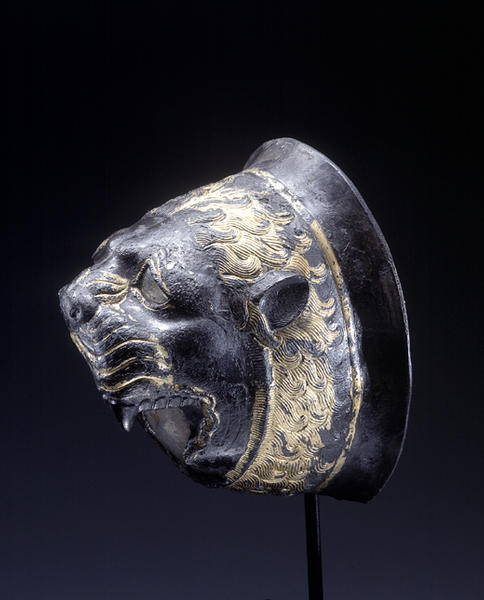獅子頭形杯
- アケメネス朝ペルシア
- 前5世紀-前4世紀
- 鍍金銀
- H-12.5 D-12 W-15.3
金製・銀製容器(古代バクトリア遺宝展)
バクトリア遺宝で容器は大きな部分を占め、22点の金器(作品123~144)、26点の銀器(作品97~122)が含まれる。銀器の中には背の高いアケメネス朝の灌頂用ゴブレット型をしたものが6個(作品103~106、108、109)あるが、その装飾はヘレニズム期の特徴をもっている。これに似たカップを、線刻や押し出し技法で奉納金板に表された神官が持っている。同様に灌頂用のリュトンが5個(作品116~119、122)あるが、その内3個(作品118、119、122)は器前方の断片である。更に8個の銀製灌頂用浅鉢(作品97~99、101、102、111~113)があるが、金製の器と同様の目的に使われた。18個の金製灌頂用鉢(作品123~140)は等しく丸い底と広がった縁をもっている。ピクシス型をした容器(作品142)は蓋がついており、これらの器の中では一番古い部類に属している。特に興味深いものは香炉(作品141)で内側に四つの環が付き、これに紐をとおして提げたものであろう。
これらの器は概して大英博物館のオクサス遺宝よりも大振りであるが、同じ用途に使われたものと思われ、ペルセポリスの浮彫に刻まれた人物が持つ器に近い形状をしている。この関連からこれらの器の年代を考えることができる。これとともに、ペルセポリス型のゴブレットやリュトンを作る光景が、エジプトのヘルモポリス・マグナにあるペトシリスの墓のプロナオスに浮彫で表されていることは特筆に価する。マスカレラによれば、この浮彫は前300年頃の鍛金工房の様子を描いたものに相当する。
牡鹿形リュトン
香炉
ロゼット文浅鉢
ロゼット文浅鉢
ロゼット文フィアラ杯
ロゼット文鉢
フィアラ杯
ロゼット文浅鉢断片
ロゼット文鉢
ロゼット文鉢
ロゼット文鉢
ロゼット文鉢
ロータス・パルメット文鉢
ロゼット文鉢
人頭装飾鉢
ロゼット文鉢
植物文杯
ケートス文皿
鉢
人物装飾鉢
馬形リュトン
馬形リュトン断片
ラマッス形リュトン断片
双獅子形柄杓装飾
円盤(鏡)
ライオングリフィン形リュトン断片
浅鉢
浅鉢
浅鉢
鉢
鉢
鉢
鉢
鉢
鉢
鉢
鉢
鉢
鉢
鉢
鉢
鉢
鉢
鉢
蓋付鉢
解説(古代バクトリア遺宝展)
前5―前3世紀頃
鍍金銀
高12.5 cm 幅15.3 cm 奥行12.0 cm
この容器は獅子頭を象った外殻の内部に丸底の容器を取り付け、西アジアに古くからある杯の様式を作り出している。耳の下から顎に巡らされた鎬の立った襟巻きのような鬣意匠も西アジアの伝統を踏襲している。眼には内側から水晶が嵌め込まれている。大きく開かれた獅子の口の線は西アジアでは一般に単純な弧を描いているに過ぎないが、この杯に見られる波うつ唇の写実的な表現は西アジアではなく、地中海域から黒海沿岸地域のギリシャ文化圏の建築意匠や宝飾品に見られるものである。更にペルシャ美術に見られる獅子の鬣は鱗状に固く表現されているのが常であり、耳は後ろに伏せられた表現が一般的であるのに対し、この杯の優美に逆立つ鬣の房や開いた耳の表現もまた地中海世界由来の感性が入っているのであろう。エルミタージュ美術館所蔵、黒海の北、クリミア半島のパンティカパイオンから出土した腕輪に付けられた獅子頭の装飾は、この杯の意匠の原型を示しているのかもしれない。
このような獅子の類似の表現はタフティ・サンギーンのオクサス神殿址から発掘された象牙の剣の鞘に見られる。この鞘はアレクサンダー大王の東征とともにペルシャからこの地域にもたらされたものと考えられているが、これはむしろ当地で作られたギリシャ様式の強い象牙細工の一つであると思われる。これらは東西の意匠が優美に統合された中央アジアの様式であると言えるのではないか。
Catalogue Entry
ca. 5th‐3rd century B.C.
Gilded silver
H. 12.5 cm, W. 15.3 cm, Depth 12.0 cm
This vessel has a lion's head-shaped end which is fitted to a round-bottomed vessel, and is a type of cup that had been created in West Asia since antiquity. The standing ridge, collar-like mane which runs from beneath the ears around the jaw line also traces its origins far back into West Asian history. The eyes are fitted from the inside with crystal insets. The wide open mouth was generally shown in West Asia by a simple curved line, but here we can see the wavy lips shown in a realistic form not found in West Asia. This form is found in architectural and jewelry design from the Greek cultural sphere which spread from the Mediterranean to the Black Sea region. Persian art depictions of lion manes were normally scale-like and formalized and the ears were shown held flat against the head. Instead, here we see the elegantly raised mane hairs, and the raised, opened ears. These elements reveal a sense for realism that would have originated in the Mediterranean region. A lion head decoration that would have been attached to the bracelets, excavated from the Pantikapaion on the Crimean Peninsula and today in the Hermitage collection, may show the model for the present lion head's expression.
Similar lion expressions can be found on an ivory sword sheath excavated at Takht-I Sangin. This sword sheath was thought to have been brought to the region from Persia along with Alexander the Great's eastern conquest, but in fact this sheath can be thought to be one of ivory works made in Central Asia, in the style with strong influence of Greeks. These images of lions can be called a Central Asian style that nimbly blends the aesthetics of East and West.
Vessels
The "vessels" division is represented by a relatively large number of objects.There are 22 items of gold (cat. Nos. 123-144) and 26 of silver (cat. Nos. 97-122). Among the silver vessels, there are 6 goblets (cat. Nos. 103-106, 108, 109) tall libation vessels Achaemenid in form, but decorated in a style which is typically Hellenistic. Similar cups are held by the magi represented on the relief sculptures and votive plaques. Three rhyta made for a similar purpose are unfortunately in a fragmentary condition (cat. Nos. 118, 119, 122). In addition there are 8 shallow bowls (cat. Nos. 97-99, 101, 102, 111-113) for ritual libations. The gold vessels were used for the same purpose; there are 18 libation bowls, of simple form, most of which have a rounded base and everted rim (cat. Nos. 123-140). One tall vessel of a pyxis type with a lid (cat. No. 142) appears to be the earliest of the vessels in the collection. Of special interest is an incense burner in the form of a censer with four rings for suspension (cat. No. 141).
Although the number of vessels in this collection is considerably larger than those of the Oxus Treasure in the British Museum, they probably served the same function. The vessels of both collections are closely paralleled by the vessels held by worshippers depicted on the Persepolis reliefs. This observation makes it possible to date them. It is worth adding here that the manufacture of goblets of similar shape and of rhyta in the Persepolitan style is depicted on a relief in a pronaos on the northern wall of the tomb of Petosiris at Hermopolis Magna in Egypt. According to Muscarella, the reliefs attest the manufacture of embossed articles in Egypt right up until 300 BC.
牡鹿形リュトン
香炉
ロゼット文浅鉢
ロゼット文浅鉢
ロゼット文フィアラ杯
ロゼット文鉢
フィアラ杯
ロゼット文浅鉢断片
ロゼット文鉢
ロゼット文鉢
ロゼット文鉢
ロゼット文鉢
ロータス・パルメット文鉢
ロゼット文鉢
人頭装飾鉢
ロゼット文鉢
植物文杯
ケートス文皿
鉢
人物装飾鉢
馬形リュトン
馬形リュトン断片
ラマッス形リュトン断片
双獅子形柄杓装飾
円盤(鏡)
ライオングリフィン形リュトン断片
浅鉢
浅鉢
浅鉢
鉢
鉢
鉢
鉢
鉢
鉢
鉢
鉢
鉢
鉢
鉢
鉢
鉢
鉢
鉢
蓋付鉢
